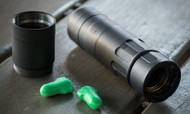Suppressed Silence: The History, Legality, and Benefits of Suppressors
Posted by Arms Protection on Oct 6th 2025
Few firearm accessories are surrounded by more myth and misinformation than the suppressor. Far from the "silencers" portrayed in movies, these devices are essential safety tools that are quickly becoming standard equipment for responsible shooters and hunters. At Arms Protection, we believe in equipping our customers with the knowledge to make informed decisions about NFA items.
Let's dive into the history, clarify the terminology, and explain why a suppressor should be your next firearm purchase.
Suppressor vs. Silencer: The Naming Debate
The device was originally patented in 1909 by Hiram Percy Maxim (son of machine gun inventor Hiram Stevens Maxim) and marketed as the "Maxim Silencer." This is where the enduring confusion began. In reality, a firearm suppressor does not produce silence; it reduces the muzzle blast noise.
A well-engineered suppressor typically reduces the sound pressure level of a gunshot by 20 to 35 decibels (dB). While this is a massive reduction—often bringing the sound level of a large caliber rifle down from a hazardous 165 dB to a still-loud but safer 130-140 dB—it remains clearly audible. For this reason, the industry and informed shooters prefer the more accurate term: suppressor.
A History of Misunderstanding: The NFA of 1934
Why do law-abiding citizens have to navigate months of paperwork just to buy what is essentially a muffler? The answer lies in the National Firearms Act (NFA) of 1934.
The NFA was enacted during the Prohibition-era gangster boom and was intended to restrict certain weapons commonly used by criminals like Al Capone. Arbitrarily, suppressors were included in the same category as machine guns and short-barreled rifles (SBRs).
- The Tax Stamp: The NFA established a $200 federal tax stamp on the transfer of these items. At the time, $200 was roughly equivalent to half the cost of a new Ford automobile or several thousand dollars today. This effectively placed suppressors out of reach for the average citizen for decades, stifling their adoption as a safety device.
- The Legacy: Today, the $200 tax remains, making the purchase of a suppressor a federally regulated NFA item.
The Practical Benefits: Safety, Control, and Communication
The benefits of using a suppressor are scientifically proven and universally recognized by medical organizations like the CDC and NIOSH as a primary tool for hearing conservation.
Hearing Protection (The #1 Reason)
A gunshot impulse is extremely loud—far exceeding the 140 dB threshold for immediate, permanent hearing damage. Since most hunters and shooters are inconsistent about wearing earplugs, a suppressor acts as an engineering control to mitigate noise at the source. Suppressors are vital for preserving the hearing of shooters, instructors, and even hunting dogs.
Recoil and Muzzle Blast Reduction
By trapping and slowing the rapidly expanding propellant gases, a suppressor also acts as a highly effective muzzle brake, reducing felt recoil and eliminating blinding muzzle flash. This leads to:
- Increased Accuracy: Less felt recoil means less flinching and better form.
- Faster Follow-Up Shots: Muzzle stability allows you to get back on target immediately, which is crucial for hunting and defensive applications.
Improved Communication
Reduced noise allows for safer, clearer instruction on the range and better situational awareness in the field. This improved communication is so significant that military branches like the US Marine Corps have begun fielding suppressors to all combat personnel.
Navigating the Legal Landscape: Your Suppressor Purchase
The good news is that suppressors are legal for civilian ownership in 42 states. However, purchasing a suppressor requires following the federal NFA process via the ATF Form 4.
The Form 4 Process in Brief:
When you purchase a suppressor, you are applying to transfer an existing NFA item from our inventory to you (or your NFA Gun Trust).
- Purchase and Submit: You select and pay for the suppressor and the $200 Tax Stamp.
- Application: You complete the ATF Form 4 (Application for Tax Paid Transfer and Registration of Firearm).
- Verification: You submit fingerprints and passport-style photos as part of a federal background check.
- Wait for Approval: The suppressor remains in our secure inventory until the ATF approves your application and issues the physical or digital Tax Stamp.
While the process requires patience, modern eForm 4 submission has significantly reduced wait times. We are here to guide you through every step of the NFA paperwork process.
>> Ready to start the paperwork? View our full selection of suppressors and silencers and secure your NFA item today.
Shop Firearm Suppressors
A Special Note on Airguns
While firearm suppressors are heavily regulated by the ATF, airgun suppressors are generally not considered firearms and are therefore unregulated by the NFA. Airguns with integrated suppression or attachable moderators offer an accessible entry point to experiencing suppressed shooting in your backyard range or on the farm.
>> Experience quiet shooting instantly with no tax stamp required.
Browse Airguns and Moderators
The suppressor is more than just a tool for noise reduction; it's a vital piece of safety equipment that improves every aspect of the shooting experience. Don't let old laws or myths keep you from a quieter, more enjoyable time on the range.
- The Tax Stamp: The NFA established a $200 federal tax stamp on the transfer of these items. At the time, $200 was roughly equivalent to half the cost of a new Ford automobile or several thousand dollars today. This effectively placed suppressors out of reach for the average citizen for decades, stifling their adoption as a safety device.
- The Legacy: Today, the $200 tax remains, making the purchase of a suppressor a federally regulated NFA item.

